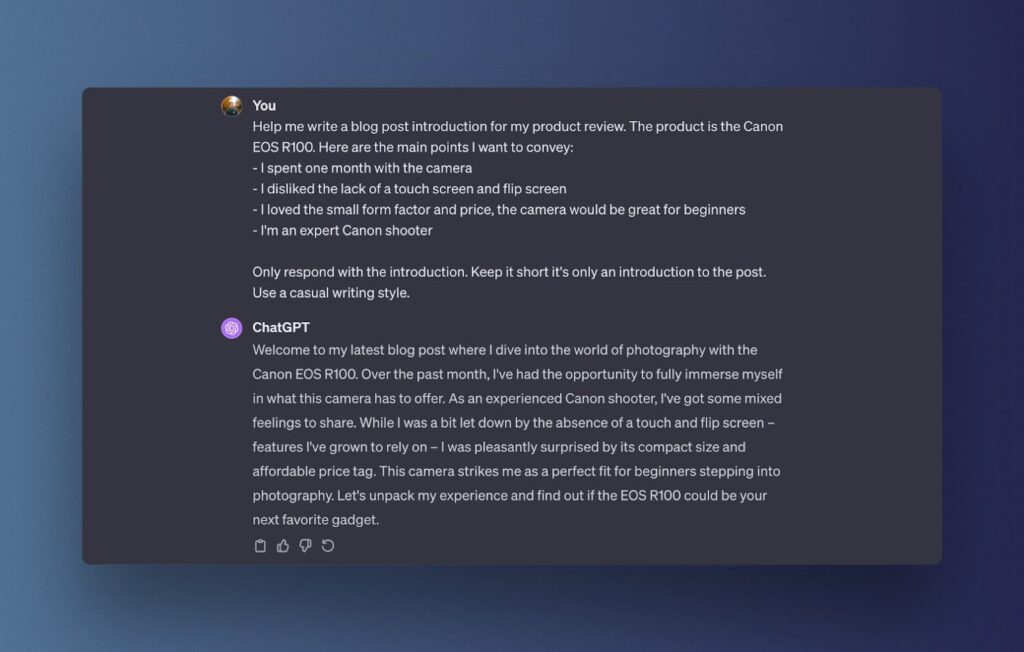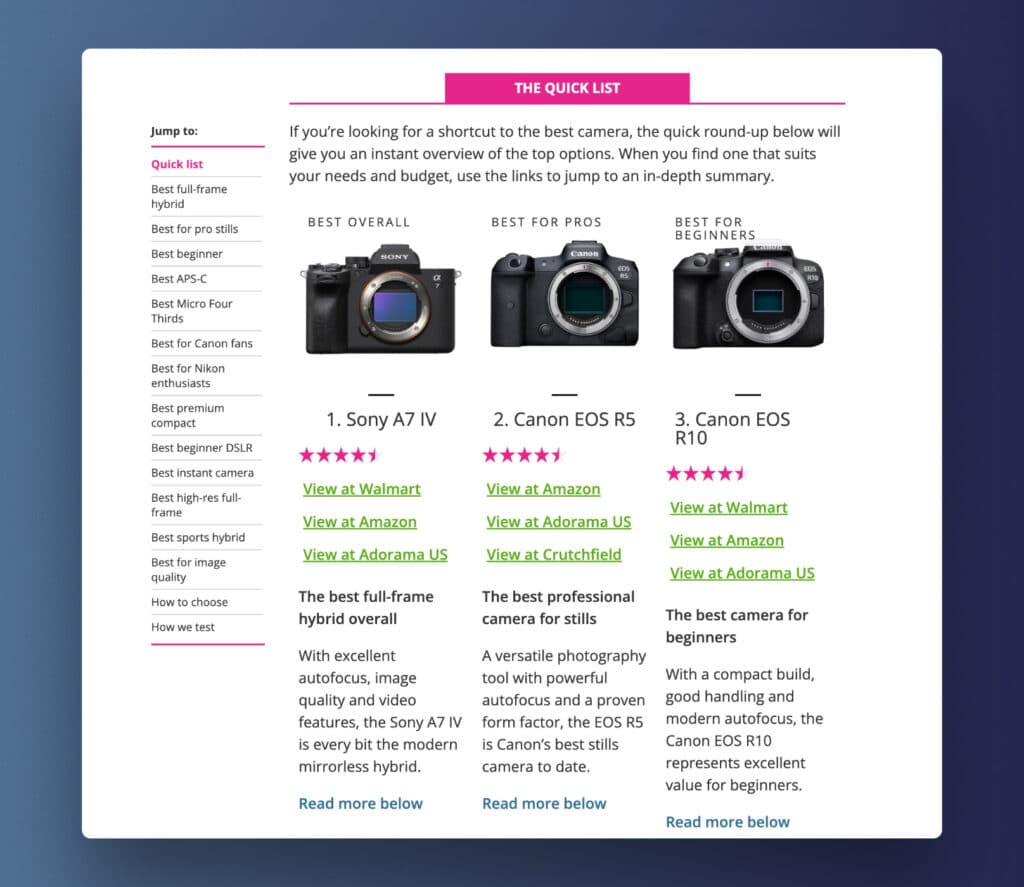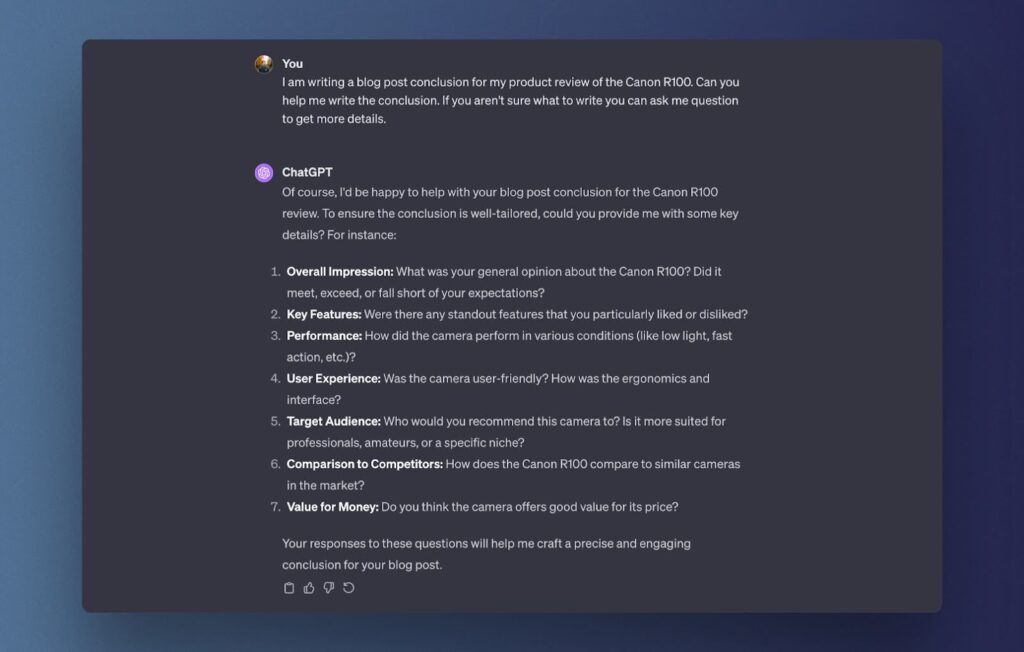How to Create Affiliate Product Reviews (With the Help of ChatGPT)
-
Andy is known for his captivating photography and shares his expertise through his blog, IHitTheButton, and YouTube channel, focusing on travel guides, camera reviews, and tutorials. In addition to his photography pursuits, he runs AwesomeStuffToBuy, a site dedicated to curating unique and cool products.
- December 18, 2023

Product reviews are easily one of the best ways to improve your affiliate efforts.
Tons of people are searching for online reviews while making their purchasing decisions. Creating a high-quality review can reward you with search traffic, video views, and, most importantly, affiliate sales conversions.

While it may be tempting to write product reviews for products you’ve never used, it’s essential to have actual hands-on experience with a product. Google even outlines guidelines on what makes a high-quality review, and one of the main factors they promote is demonstrating your own in-depth experience with the product to increase the review’s authenticity.
In this guide, we’ll go over how to create an affiliate product review and how to speed up your workflow with AI-powered tools like ChatGPT.
Using the Product
First, I just want to say that if you are considering buying a product purely to review it, don’t. You likely won’t make back your initial investment unless you already have a following. I’d recommend starting with products or services you already own and have a strong opinion about. That way, you can work on your review posts with little upfront cost.

The main thing you need to focus on is using the product itself. Some products can be reviewed in a few days, but others can take even a month of use. This is where you blend your expertise in a product with your review.
If you are new to the product category you’re reviewing, it’s okay to say that in your review. You basically need to be as authentic and transparent as possible in your review process.
While using the product, no matter if it’s software or a physical product, I recommend taking pictures/screenshots during the process. This will allow you to include images in your review with ease.
After you know your way around a product and have thoughts to share, we can actually start to focus on writing the product review.
Writing an Affiliate Product Review (Step-by-Step)
Now that you’ve got your hands on a product and have thoughts to share, let’s dive into actually writing the review with the help of ChatGPT.
This post will assume you already have a blog, but if you don’t have one and you’re interested, you can learn how to start a blog.
Blogs are a great way to share thoughts, build affiliate income, and build an audience. Creating videos can also pair well with a written blog post, so keep that in mind if that’s something you want to work on.
Even short videos for social media sites like TikTok can lead to great traction. I recommend familiarizing yourself with how different affiliate programs, like Amazon’s, may require you to link in specific ways. This could include indicating that it’s an ad on social media or including a disclaimer in your blog post.
Writing a Strong Introduction
When writing a product review, some of the first things you’ll want to share are how long you’ve spent with the product, your expertise, and, of course, the product’s full name.
Here is an example ChatGPT prompt to help write your post’s introduction:
Help me write a blog post introduction for my product review.

Here is an example ChatGPT prompt to help write your post’s introduction:
Help me write a blog post introduction for my product review.
The product is [Product Name].
Here are the main points I want to convey:
– [Include your bullet points here.]
– [This will include an overview of your experience and expertise.
Of course, you can modify the prompt at the end with a different writing style.
It’s also important to modify the text that’s generated; this is just an easy way to have a stepping stone if you are having writer’s block.
Creating a Review Summary Section

Let’s face it, we all skim through content these days. That’s why kicking off your review with a punchy, to-the-point summary is essential.
It’s all about giving your readers a brief overview right up front—what’s cool about this product and why they should care.
There are many WordPress plugins to display featured products in a template for a summary section, like Lasso, Affiliatable, and AAWP.
Of course, you can also use the WordPress block editor or a custom visual for this section of your post. If you’re working on a YouTube video review, custom visuals will help make your video more engaging and keep your audience hooked.
Now, who’s going to love this product? Make sure to spell out who the ideal user is and why this product is a perfect match for them. For example, I’m an experienced photographer, but a beginner’s camera may not be for me, but I can directly say that in the summary section.
You can also include a star rating in your summary section so readers can instantly get a feel for how much you like the product. To improve the SEO of the post, you can also use WordPress plugins to add review schema.
This will give Google the correct schema to show a preview of your review’s rating on search engine result pages.
Don’t just reel off a list of the product specs. Your readers want your take on things—what worked well, what didn’t, and why they should (or shouldn’t) get this product. That personal touch is what makes your review stand out and helps build trust. This is easily done with a pros and cons section.
Wrap it up with a killer Call to Action (CTA). Throw in some links to where they can buy the product, offering options and making it super easy for them to take the next step. You can use Geniuslink to create a choice page that allows users to pick what retailer to buy from (plus keep the links affiliated). I typically prefer this when reviewing camera gear since a lot of user’s have their own preferences about where to buy it.
And if you’re hitting a dead end while trying to write a summary, ChatGPT can be a great help. It’s a great way to turn any notes you may have about the product into an engaging summary that will keep your readers scrolling.
Here’s an example prompt you can use:
Help me write a short, engaging product summary that’s straight to the point.
Include a call to action to buy the product at the end.
Here are the main points I want to convey:
– [List Features]
– In my review following this summary I give it [X]/5 stars
– Pros: [List the Pros of the Product]
– Cons: [List the Cons of the Product]
Only respond with the content I asked for. Use a casual writing style.
By providing a summary section at the top of your article, you’ll often increase conversion rates for your affiliate sales. Many users will just see a positive review and click over to the retailer.
Writing the Body of the Review
When crafting the body of your product review, it’s essential to provide a detailed and honest examination of the product or service. Bloggers will know how important it is to go into as much detail as possible while writing.
Here’s a breakdown of what to include in your review:
Product/Service Specifications: Start with the basics. Include the product’s specifications, such as size, weight, color options, technical features, or any unique aspects. This sets the stage for your readers and gives them a clear picture of what you’re reviewing.
Testing Process: Transparency is key. Share how you tested the product. Did you use it daily? in various conditions? This section should give your audience insight into your testing methodology, lending credibility to your review.
Reviewing Features or Aspects in Order: Now, dive into the heart of your review. Tackle each feature or aspect of the product one by one. This could be anything from the user interface to performance, durability, comfort, efficiency, or any other relevant features. Discuss what you liked and disliked, providing examples from your experience.
For each feature or aspect:
- Describe the Feature: Explain what the feature is and what it’s supposed to do.
- Your Experience: Share your personal experience with this feature. Did it work as expected? Was it better or worse than anticipated?
- Comparison: If applicable, compare it with similar features in other products. This can help readers understand the product’s standing in the market.
Remember, the goal is to be as detailed and honest as possible. Readers are relying on your experience to guide their decisions, so providing them with a thorough, well-structured review is crucial.
Also, don’t hesitate to include personal anecdotes or relevant stories related to the product. These not only make your review more engaging but also help illustrate your points.
Include Competitors and Alternatives
When readers are considering a purchase, they often weigh their options by looking at similar products. This section of your review should guide them through this comparison process.
Start by acknowledging that your readers are exploring their options. Offer a brief overview of how the product you’re reviewing fits within the broader market. For instance, is it a high-end choice, a budget-friendly option, or somewhere in between?
While this isn’t a full blown comparison article we’re writing, it can still be helpful to list where it fits in.
For each alternative, mention key aspects like price, quality, and target audience. This could look something like:
- “Best for Budget Buyers: [Product Name] – A more affordable option that still offers great features.”
- “Top Choice for Tech Enthusiasts: [Product Name] – Packed with the latest tech features, ideal for those who want cutting-edge technology.”
- “Best for Durability: [Product Name] – Perfect for those who need a product that can withstand heavy use.”
Clarify who each alternative is best suited for. This could be based on budget, specific needs (like durability or portability), or user expertise (beginners vs. advanced users). A user might not even know a cheaper alternative to the product they are looking up exists.
By including this section, you’re not only offering a comprehensive review of the product but also helping your readers make an informed decision by understanding how it stacks up against its competitors.
This approach adds value to your review and can significantly enhance your credibility as a reviewer.
Including Photos in the Review
Incorporating images and videos into your product review is not just about visual appeal; it’s about enhancing the authenticity and depth of your review.
Here’s how to do it effectively:
Highlighting First-Hand Experience: Images and videos from your personal experience with the product are invaluable. They demonstrate that you’ve actually used the product and provide a real-world perspective. This can include unboxing videos, images of the product in use, or even comparison shots with similar products.
Ideal Images and Videos to Include:
- Product in Action: Show the product being used in its intended environment. This gives the reader a sense of its functionality and size.
- Close-Ups: Detailed shots of the product, highlighting its build quality, material, and features. When reviewing cameras, I love to include photos of all of the buttons and ports so user’s know exactly what to expect from the camera.
- Before and After: If applicable, show the impact of using the product, like a before-and-after shot.
- Comparison Images: Side-by-side comparisons with similar products can be very informative.
- Videos: Short clips that demonstrate the product’s features, ease of use, or any unique aspects.

While you can use ChatGPT and DALL-E 3 to generate images they won’t be true product images.
However, you can use ChatGPT to brainstorm ideas for the types of images and videos that would be most effective for your review. ChatGPT can help you create detailed descriptions for potential visuals, which you can then use as a guide when capturing your own photos or videos.
One place that AI can help, though, is if you’re using Photoshop AI. With the generative fill options in Photoshop, you can change product image backgrounds, easily create white backdrops, or remove any mistakes in your photographs.

Remember, the goal of including images and videos is to provide a more immersive and informative experience for your readers. Original visuals from your own use of the product add a layer of trust and credibility that stock photos or manufacturer’s images can’t match.
They help the reader visualize the product in a real-world setting, making your review more relatable and trustworthy. The goal isn’t to capture the best photo, but to show your experience with the product.
Writing the Review Conclusion
Wrapping up your review with a strong conclusion is crucial. It’s your final chance to leave an impression on your readers and guide them towards making a decision. Here’s how you can craft an impactful conclusion:
Summarize Your Key Points: Start by briefly summarizing the most important aspects of your review. Highlight the main features of the product, your experience using it, and how it compares to its competitors. This recap helps to reinforce the key messages of your review.
Offer Your Original Opinion: Now, share your personal verdict. Were you impressed with the product? Did it meet, exceed, or fall short of your expectations? This is where your authenticity shines. Readers value your unique perspective, so be honest and direct about your feelings towards the product.
Actionable Recommendations: Provide clear, actionable advice. If you recommend the product, say so explicitly. Likewise, if you don’t recommend it, be straightforward about that as well. If the product is best suited for a particular audience (e.g., beginners, professionals, budget-conscious users), make sure to mention this.
Encourage Reader Engagement: Invite your readers to interact. Encourage them to leave comments, share their own experiences, or ask questions. This not only helps in building a community around your content but also gives you insights into your audience’s preferences and thoughts.
End on a Memorable Note: Conclude with a memorable statement or a thought-provoking question that sticks with the reader. It could be about the future of the product category, an emerging trend, or a reflection on how this product fits into the bigger picture.
Remember, your conclusion is more than just an endnote; it’s a powerful tool to influence your reader’s decision-making process. Make it count by being insightful, honest, and engaging.
Tips for Prompting ChatGPT
While we have gone over a few basics of ChatGPT in this post, I will show you more detailed tips for getting the most out of ChatGPT. This is where learning how to effectively prompt it comes in.
Be as Detailed as Possible: The more detailed and clear your prompt is, the more accurate and useful the response will be. Think of it as giving directions; the more precise you are, the better the outcome. One hack I love, not sure what to prompt? Ask it to ask you questions that would be helpful for it! So you could ask, “If you aren’t sure what to write, you can ask me question to get more details.” This will likely result in ChatGPT asking you for additional details for the section.

Give ChatGPT Inspiration: You don’t necessarily need to feed ChatGPT examples but it can help, especially if you’re looking for responses in a specific style or format.
For instance, if you’re writing a product review and want to maintain a certain tone or structure, providing a sample of what you’re aiming for can guide ChatGPT to produce similar content.
Overview of the Prompting Process:
- Define Your Objective: Clearly state what you want from ChatGPT. Are you looking for ideas, writing assistance, or something else?
- Provide Context: Give enough background information. For a product review, this might include the product’s name, its features, your experience with it, and the review’s intended audience.
- Set the Tone and Style: If you have a specific tone or style in mind, mention it in your prompt. For example, a casual and conversational tone or a more formal and detailed style.
- Include Examples, if Applicable: If you have a specific format or example in mind, include that in your prompt. This could be a snippet of a review you like or a particular format you’re aiming to replicate.
By carefully crafting your prompts, you can harness the full potential of ChatGPT, making it a valuable tool in your content creation process. Remember, the key is in the details; the more specific you can be, the better ChatGPT can assist you.
Conclusion
I hope you enjoyed this step-by-step guide to writing affiliate product reviews with the help of ChatGPT. Writing reviews is easily one of the most common ways to make money online. With enough traffic, you can turn your blog into an online business purely through affiliate income.
Of course, there are countless other optimizations you can make to your article, like writing an FAQ section, building backlinks, creating product tutorials, optimizing for SEO, and much more.
Crafting a comprehensive and engaging affiliate product review is a nuanced process that involves much more than just sharing your thoughts on a product. From the initial summary that grabs attention, through the detailed body where you dissect the product’s features and compare it with competitors, to the strategic use of images, and finally, each step plays a crucial role in creating an honest review that not only informs but also connects with your audience.
Remember, the key to a successful review lies in balancing detailed information with personal insights and clear, actionable guidance for your readers. By following the structure and tips outlined in this guide, you’re well-equipped to create reviews that are not just informative but also engaging and persuasive, driving both search engine traffic and affiliate commissions.
So, whether you’re an experienced affiliate marketer or just starting out, use this guide as a blueprint to craft reviews that stand out when writing your next product review.
Happy reviewing!
You can find more on my travel blog or YouTube channel. I also help bloggers write more through my platform for bloggers called RightBlogger.
Author
-
Andy is known for his captivating photography and shares his expertise through his blog, IHitTheButton, and YouTube channel, focusing on travel guides, camera reviews, and tutorials. In addition to his photography pursuits, he runs AwesomeStuffToBuy, a site dedicated to curating unique and cool products.
Author
-
Andy is known for his captivating photography and shares his expertise through his blog, IHitTheButton, and YouTube channel, focusing on travel guides, camera reviews, and tutorials. In addition to his photography pursuits, he runs AwesomeStuffToBuy, a site dedicated to curating unique and cool products.
Related posts

What is a Geni.us Link?

Building Diverse Income Streams with Doug Cunnington

Building Wealth Through Video with Matt Hughes

Can you Include Affiliate Links in Emails?
More revenue from every link you share
Geniuslink makes localizing, tracking, and managing smart links dead simple, so you can earn more without added work.
